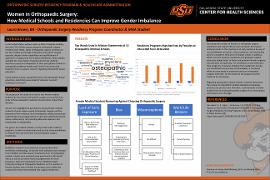| dc.contributor.author | Brown, Laura | |
| dc.date.accessioned | 2023-11-02T20:46:39Z | |
| dc.date.available | 2023-11-02T20:46:39Z | |
| dc.date.issued | 2023-02-17 | |
| dc.identifier | ouhd_Brown_womeninorthopaedicsurgery_2023 | |
| dc.identifier.citation | Brown, L. (2023, February 17). Women in orthopaedic surgery: How medical schools and residencies can improve gender imbalance. Poster presented at Research Week, Oklahoma State University Center for Health Sciences, Tulsa, Ok. | |
| dc.identifier.uri | https://hdl.handle.net/11244/339911 | |
| dc.description.abstract | Background: Studies about women in orthopaedics was once a rarely researched topic, though it has seen an increase in interest in the last five to 10 years; a trend that parallels with the changes in our culture as a country that is pivoting towards equality and the importance of diversity and inclusion in the workplace. Recent studies focused on the medical school experience and how early exposure to orthopaedic surgery through clinical rotations and outreach programs, as well as having access to a role model or mentor, could be the most critical reason women choose orthopaedics. In addition to early exposure, other studies found gender bias, work/life balance, workplace culture, and perceptions on physical strength as explanations for this same phenomenon. These studies spotlight the many factors that play into female students’ decisions. However, there is a gap in research on how medical schools, specifically those with osteopathic-based education, sway a student's decision on residencies. | |
| dc.description.abstract | Objective: This study looks at why female medical students do not choose orthopaedics and specifically how osteopathic medical schools further impact their decision. The aim is to highlight the perceptions among female medical students of what makes a good orthopaedic surgeon and the demands of the residency, and if osteopathic medical schools are inadvertently encouraging women to go into traditionally female-heavy residencies by not providing adequate exposure and mentorship in orthopaedics. With this knowledge, the hope is that medical schools, in conjunction with residency programs, can improve the rate of females into orthopaedic surgery residencies. | |
| dc.description.abstract | Methods: Qualitative research was conducted using transformative worldview methodology. 16 articles were collected and reviewed from PubMed, and the mission statements from 15 Osteopathic medical schools were analyzed using word count in Microsoft Word, as well as an online word cloud generator for word frequency. Data was requested from the Oklahoma State University College of Osteopathic Medicine on the number of female students who matched into primary care residencies compared to those that matched into surgical residencies. | |
| dc.description.abstract | Results: Increasing the number of females in orthopedic surgery residencies will require efforts across all levels. All research analyzed points to the importance of early exposure by way of musculoskeletal curriculum, clinical rotations, and mentorship prior to a student’s third year of medical school. In addition, efforts must be made by residencies and graduate medical education departments to foster and promote female surgeons into positions of leadership. For residencies to see diversity in their programs, it requires initiative from leadership, faculty, and coordinators to promote its attainability. A concerted effort must be made to modernize what an orthopaedic surgeon looks like– for the health of the program and the health of its community. | |
| dc.description.abstract | Regarding osteopathic medical schools, research shows that the mission of osteopathic medical education emphasizes primary care practice and, therefore, could dissuade a female student from choosing orthopaedic surgery, thus continuing to contribute to the shortage. | |
| dc.format | application/pdf | |
| dc.language | en_US | |
| dc.publisher | Oklahoma State University Center for Health Sciences | |
| dc.rights | The author(s) retain the copyright or have the right to deposit the item giving the Oklahoma State University Library a limited, non-exclusive right to share this material in its institutional repository. Contact Digital Resources and Discovery Services at lib-dls@okstate.edu or 405-744-9161 for the permission policy on the use, reproduction or distribution of this material. | |
| dc.title | Women in orthopaedic surgery: How medical schools and residencies can improve gender imbalance | |
| osu.filename | ouhd_Brown_womeninorthopaedicsurgery_2023.pdf | |
| dc.type.genre | Presentation | |
| dc.type.material | Text | |
| dc.subject.keywords | orthopaedic surgery | |
| dc.subject.keywords | graduate medical education | |
| dc.subject.keywords | gender disparities | |
| dc.subject.keywords | diversity | |
| dc.subject.keywords | osteopathic education | |
